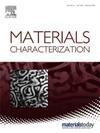Evolution of microstructure and properties of nanocrystalline NiCo alloy under high-energy laser shock
IF 4.8
2区 材料科学
Q1 MATERIALS SCIENCE, CHARACTERIZATION & TESTING
引用次数: 0
Abstract
In this study, nanocrystalline NiCo alloy was prepared through electrodeposition and subjected to high-energy laser shock (HELS) treatment to investigate the influence of laser shock on the microstructures and properties. An analysis of phase composition, microstructural evolution, texture evolution, and hardness was conducted. The results indicated that under HELS, there was no change in phase composition, while there was a slight reduction in grain size, as well as in the quantities of Low-angle grain boundaries (LAGBs) and twin boundaries (TBs). The texture evolution revealed that HELS led to a more uniform overall texture due to grain boundary (GB) mediate deformation mechanisms, along with the generation of a significant amount of 9R phases, causing a shift in texture orientation from (110) to (100). The internal structure of nanocrystalline NiCo showed an accumulation of numerous dislocations post-laser shock, with randomly oriented dislocations interacting to form Lomer-Cottrell Locks (L-C Locks) and 9R phases. Additionally, interactions with large stacking faults (SFs) also resulted in their dissociation into multiple 9R phases. The hardness enhancement was mainly attributed to the accumulation of dislocations within the grain and the generation of a significant quantity of 9R phases.
纳米晶镍钴合金在高能激光冲击下的微观结构和性能演变
本研究通过电沉积制备了纳米结晶镍钴合金,并对其进行了高能激光冲击(HELS)处理,以研究激光冲击对其微观结构和性能的影响。对相组成、微观结构演变、纹理演变和硬度进行了分析。结果表明,在 HELS 处理下,相组成没有变化,但晶粒尺寸以及低角度晶界(LAGB)和孪晶界(TB)的数量略有减少。纹理演变表明,由于晶界(GB)介导的变形机制,HELS 使整体纹理更加均匀,同时生成了大量 9R 相,导致纹理取向从(110)转变为(100)。激光冲击后,纳米镍钴晶体的内部结构显示出大量位错的累积,随机取向的位错相互作用形成了 Lomer-Cottrell Locks(L-C Locks)和 9R 相。此外,与大型堆叠断层(SF)的相互作用也导致它们解离成多个 9R 相。硬度的提高主要归因于晶粒内位错的积累和大量 9R 相的生成。
本文章由计算机程序翻译,如有差异,请以英文原文为准。
求助全文
约1分钟内获得全文
求助全文
来源期刊

Materials Characterization
工程技术-材料科学:表征与测试
CiteScore
7.60
自引率
8.50%
发文量
746
审稿时长
36 days
期刊介绍:
Materials Characterization features original articles and state-of-the-art reviews on theoretical and practical aspects of the structure and behaviour of materials.
The Journal focuses on all characterization techniques, including all forms of microscopy (light, electron, acoustic, etc.,) and analysis (especially microanalysis and surface analytical techniques). Developments in both this wide range of techniques and their application to the quantification of the microstructure of materials are essential facets of the Journal.
The Journal provides the Materials Scientist/Engineer with up-to-date information on many types of materials with an underlying theme of explaining the behavior of materials using novel approaches. Materials covered by the journal include:
Metals & Alloys
Ceramics
Nanomaterials
Biomedical materials
Optical materials
Composites
Natural Materials.
 求助内容:
求助内容: 应助结果提醒方式:
应助结果提醒方式:


